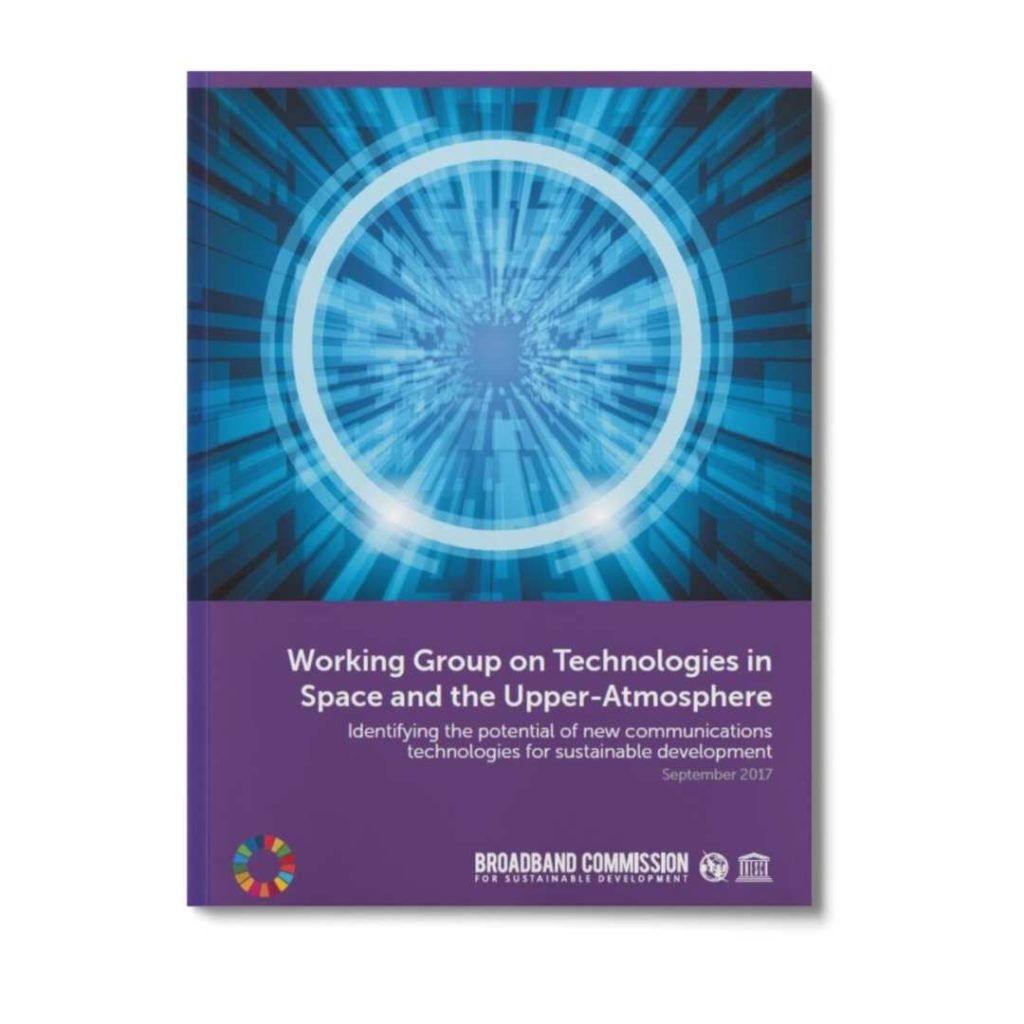How can we enable technologies in space and the upper-atmosphere so that they can be employed to connect the unconnected?
Chaired by Mr. Rupert Pearce, Chief Executive Officer of Inmarsat PLC, the Broadband Commission for Sustainable Development’s 2017 Working Group on Technologies in Space and the Upper-Atmosphere was convened to address the vast potential of satellite and high-altitude technologies to bring reliable broadband connectivity to every corner of the world. Bringing together expert representatives from satellite and upper-atmosphere communication technology sectors, the resulting 2017 Report put forth not only the scope of the potential of these technologies and their existing use-cases, but also provided commercial and regulatory considerations for implementing successful use-case frameworks and policy recommendations for how to include developing countries in the technology revolution as well.
Setting the Stage
Background Overview
Space-based and upper-atmosphere technologies evolved dramatically in the early 2000s. While satellites had long been a part of the telecommunications ecosystem, technological innovation and an explosion in capacity have enabled them to play a key role in emerging broadband markets.
These technologies have proven to have a positive impact on sustainable development within the education, health, banking, agriculture, oil/gas exploration, maritime, environmental management, disaster response, and government services sectors. The scope of possibilities that come with technologies in space and the upper-atmosphere is immense, and as hardware innovations, operational improvements, cost reductions, reach, and capacity grow, space-based and upper-atmosphere technologies have increasingly proven to be the ideal technology solutions for expanding broadband coverage in developing countries.
The Way Forward
Conclusions and Recommendations
The Working Group on Technologies in Space and the Upper-Atmosphere’s 2017 report, titled Identifying the Potential of New Communications Technologies for Sustainable Development, documents the substantial innovation in space-based and upper-atmosphere communications technologies that occurred from 2007 to 2017, and which will continue to change the broadband landscape over the next ten years.
The Working Group report also identifies the unique characteristics and benefits of various space-based and upper-atmosphere technologies, and examines some of the use cases and applications that leverage these technologies to achieve the Sustainable Development Goals (SDGs). Finally, the report addresses regulatory and commercial considerations related to implementing these solutions and offered some policy recommendations to assist administrations in developing countries in tapping into the benefits of this technology revolution.
Technological innovation alone will not be sufficient to enable space-based and upper-atmosphere technologies to reach their full potential for helping to realize the SDGs. Governments and other stakeholders should support policy decisions that will promote the further development and adoption of these technologies.
Accordingly, the Working Group recommends the following:
- Ensure sufficient protection. Policy makers should strive to create an environment that promotes further growth and adoption of space-based and upper-atmosphere technologies while optimising resource use consistent with the needs of their populations. In developing a balanced spectrum policy and making frequency assignments, regulators should avoid steps that would increase harmful interference to, or reduce flexibility of, these technologies. In shared bands, this includes ensuring that space-based and upper-atmosphere systems are protected from interference from existing and new services.
- Harmonize spectrum where possible. Globally-harmonized spectrum for broadband technologies create economies of scale that drive faster deployments at lower cost, more reuse of infrastructure, and flexibility for service providers. These efficiencies are ultimately passed on to consumers. Governments should therefore expedite access to globallyharmonized radio frequencies for satellites and broadband HAPS.
- Access to necessary spectrum. Governments should ensure that broadband HAPS and broadband satellites have access to the spectrum they require to succeed in their mission of serving the underserved and relieving capacity constraints. Consistent with a balanced spectrum approach, this may include identifying new spectrum for these platforms, facilitating spectrum sharing arrangements and implementing policies allowing accelerated deployment.
- Support experimentation. To better understand the solutions these technologies can provide across a country or region, governments should sponsor case studies and pilot projects within their territories on an expedited basis. In addition to developing solutions that are customized to a country’s particular needs, such studies and pilots may help to build the body of evidence required to support legal, regulatory, procurement, and deployment decisions.
- Promote innovation. Realizing the full potential of space-based and upper-atmosphere technologies to connect unconnected areas and achieve the SDGs will rely upon continued innovation in broadband satellite technologies and broadband HAPS. Stakeholders can promote this innovation through support for standards and technology development. The technical community should emphasize development of standards that facilitate interoperability or integration among broadband radio services, including through network virtualization. · Carbon neutrality. Governments should provide incentives to reduce carbon emissions by leveraging infrastructure and terminals that require less power, which leads to less use of fossil fuels and longer- lived components.
- Drive international consensus on broadband HAPS. Because HAPS platforms can be owned by national service providers, governments should work to ensure that UN bodies such as the International Telecommunication Union, the International Civil Aviation Organization and associated regional bodies develop standards for HAPS platforms as quickly as possible to ensure trust in the systems and deployment of the networks.
- Due to their coverage, reliability, mobility, and flexibility, these new space-based technologies represent an important solution for expanding the reach and density of the global Internet, and achieving the Sustainable Development Goals (SDGs)
The Working Group Model
Composition and Activities

Mr. Rupert Pearce
Chief Executive Officer
Inmarsat PLC
- Inmarsat
- Microsoft
- ITSO
- EUTELSAT IGO
- UN-OHRLLS
- Rwanda Utilities Regulatory Authority
- ITU
- IADB
The Working Group on Technologies in Space and the Upper Atmosphere was proposed in New York (USA) in September 2016. The group then held one meeting (conference call) in December 2016 and hosted an onsite meeting at the Broadband Commission Spring meeting 2017 held in Hong Kong SAR of China on 15th March.
Focus Area
Outcome Resources
Chair
Mr. Rupert Pearce
CEO of Inmarsat PLC
Broadband Advocacy Targets
SDGs











